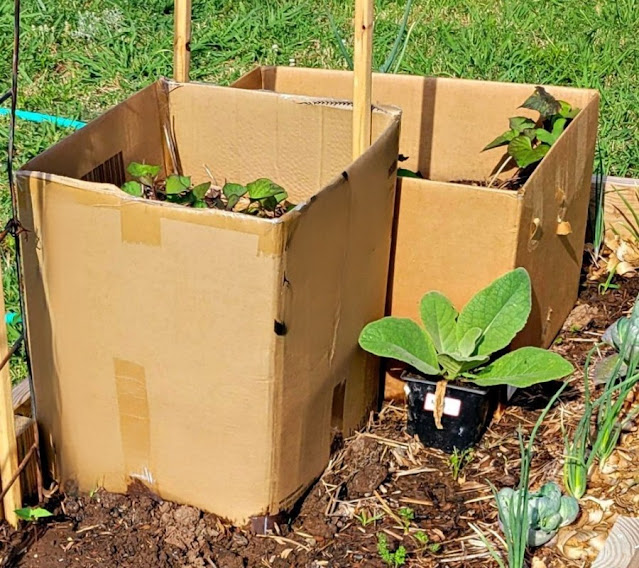If you don't have the time or money to invest in building raised beds, but you still want to start a vegetable garden, you'll learn how to grow vegetables in cardboard boxes in this post.
Even if you rent your home, you can start a cardboard box garden.
Start a vegetable garden from scratch using cardboard boxes
Gardening in containers is a quick and easy way to start a garden without a big expense and a lot of labor. And what could be cheaper to use as containers than cardboard boxes?
Obviously, those boxes are going to get wet, not just from watering your garden but also from rain. Flimsy boxes won't last long.
 |
| The soil settled quite rapidly in these cardboard boxes. Waiting a few days to plant will give you a chance to top them off with more soil. |
Using heavy-duty boxes such as these I've used to grow sweet potatoes work best. They'll only last one season, but that's long enough to grow and harvest a vegetable crop.
Is it safe to plant vegetables in cardboard boxes?
Some folks believe that boxes contain chemicals in both the cardboard and in the glue used to put them together, depending on where the boxes were manufactured.
Everything in our modern world has chemicals in it, and it's hard to get away from them. If the thought of these chemicals worries you, please don't plant in cardboard boxes.
Modern inks are usually soy-based. However I wouldn't use a box that is printed in full color, or that is covered with a glossy paper coating. I'd stick to plain brown cardboard boxes that might or might not be printed with black ink. I would also remove all tape from the boxes before planting in them.
The choice to use cardboard boxes is entirely up to you, and you alone.
Planting in cardboard boxes as outlined in this article is meant to be a temporary fix. I believe in using what you have, and starting where you are, and doing what you can. Not everyone has enough money laying around to buy the materials to make raised garden beds with wood.
Growing your own vegetables in cardboard boxes, in my opinion, is better than buying commercially-grown strawberries that are laden with pesticides. [Source]
Grow box for vegetables
You've heard of grow bags - why not grow boxes? Cardboard boxes can be used to grow nearly any vegetable plant.
Heavy duty cardboard boxes aren't hard to find. You might even have a couple in your garage right now.
Or perhaps you or someone you know can get boxes at work.
Look for this seal on the bottom. Compare the numbers in the Box Certificate seal and choose boxes with the highest numbers you can find.
The higher the number, the stronger the box.
.
Set up your cardboard box garden
The size and shape of your cardboard box will help determine what to grow in it.
Shallow-rooted vegetables such as lettuce don't need a deep box, but if you want to grow carrots, the box would need to be deeper. A tomato plant would require a deep box. You'd need a large grow box to grow potatoes.
When I grew sweet potatoes, I set the cardboard boxes on top of a raised garden bed so the soil was deeper and the potatoes could grow down below the bottom of the boxes.
I tucked the bottom flaps of the boxes up along the sides, so that the boxes had no bottom. Then the upper flaps were folded inward, providing the sides with a double layer of cardboard.
You don't have to use bottomless boxes though, especially if you don't want to disturb the grass underneath your cardboard box garden.
Fill the cardboard grow boxes
All that's left is to fill up your cardboard grow box with soil. Potting soil works fine, or you can use garden soil mixed with compost.
Then plant your seeds or transplants and treat them like any other container vegetable plant.
Containers tend to dry out faster than raised garden beds, so you may have to water more often.
Harvesting vegetables in cardboard grow boxes
If you're growing root vegetables such as potatoes, sweet potatoes, carrots and so on, harvesting is so easy.
Dump the cardboard box onto a tarp or old shower curtain, and dig through soil with your hands to find the ripe veggies!
Recycle
Use the soil from this year's grow boxes to fill up next year's new cardboard boxes, or add it to a raised bed or compost pile.
Soil is soil - it's still good!
 |
| Later in the growing season, these boxes are still holding up well. The sweet potato plants are so big, it's hard to see the boxes. |
Of course, you can recycle the cardboard after the growing season too. It can be laid flat and used to help prevent weeds from growing in your garden, or laid on the bottom of a new raised bed, under the soil. Worms love cardboard!
Or recycle the cardboard in the usual manner, either at a recycling center or through your trash company.
Garden and save money!
If you're renting a home and want to garden without tearing up the grass, a cardboard box garden might be the answer for you. Set the boxes on top of the grass and grow something!
Yes, the grass underneath may die out, but once the garden season is over and the boxes have been removed, the grass will resume growing and will fill in any bare spots.
A cardboard box garden might be the cheapest, easiest and fastest way to start a vegetable garden from scratch!
















